Lord Shiva
 Lord Shiva, one of the Trimurti or the Divine Trinity, is one of the most major deities in the Hindu Pantheon. According to the Shaiva, Shiva is considered to be the Supreme Being. According to the Smartas, Shiva is revered as one among the five primary forms of God. Except in temples like Chidambaram – where Shiva is worshipped as the Dancing Lord Nataraja, stepping over the demon Apasmara, who stands for ignorance – Shiva is usually portrayed and worshipped in the form of the Shiva linga.
Lord Shiva, one of the Trimurti or the Divine Trinity, is one of the most major deities in the Hindu Pantheon. According to the Shaiva, Shiva is considered to be the Supreme Being. According to the Smartas, Shiva is revered as one among the five primary forms of God. Except in temples like Chidambaram – where Shiva is worshipped as the Dancing Lord Nataraja, stepping over the demon Apasmara, who stands for ignorance – Shiva is usually portrayed and worshipped in the form of the Shiva linga.
Other names of Shiva
 The word Shiva comes from Sanskrit and means, “The Auspicious One”. It also means kind, pure, generous and gracious. The name, Shiva, could also be used to mean one who is shorn of the three Gunas, namely, Satva, Rajas and Tamas; and also one who purifies all by the mere chanting of His name. Dravidian tradition gives the meaning “to be red”, to the word Shiva. This may be the equivalent of Rudra, or “The Red”. Shiva is worshipped as a major deity not only in India, but also in Sri Lanka and Nepal.
The word Shiva comes from Sanskrit and means, “The Auspicious One”. It also means kind, pure, generous and gracious. The name, Shiva, could also be used to mean one who is shorn of the three Gunas, namely, Satva, Rajas and Tamas; and also one who purifies all by the mere chanting of His name. Dravidian tradition gives the meaning “to be red”, to the word Shiva. This may be the equivalent of Rudra, or “The Red”. Shiva is worshipped as a major deity not only in India, but also in Sri Lanka and Nepal.
Forms of Shiva
 Shiva is depicted in many moods, of which the Mahakala form is the most feared. This aspect of the deity destroys all in sight and dances his dance of death. He is also portrayed as a Yogi, Teacher (Dakshinamurthy), Mrityunjaya, Ardhanareeshwara, Panchabrahman (one with the five faces of Satyojata, Vamaka, Eeshaana, Tathpurusha and Aghora), Consort of Parvati (Umapati) and father of Ganesha and Skanda (or Murugan). While Shiva has these two sons from Parvati, he also has one additional son from Mohini (Vishnu’s female avatar), named Ayyappan.
Shiva is depicted in many moods, of which the Mahakala form is the most feared. This aspect of the deity destroys all in sight and dances his dance of death. He is also portrayed as a Yogi, Teacher (Dakshinamurthy), Mrityunjaya, Ardhanareeshwara, Panchabrahman (one with the five faces of Satyojata, Vamaka, Eeshaana, Tathpurusha and Aghora), Consort of Parvati (Umapati) and father of Ganesha and Skanda (or Murugan). While Shiva has these two sons from Parvati, he also has one additional son from Mohini (Vishnu’s female avatar), named Ayyappan.
Shiva’s relationship with Vishnu
 Though the Shaivait and Vaishnavite sects each claimed that their Lords were the Supreme deity, both the deities were viewed as one in the Bhagavata Purana. While Shiva was considered a manifestation of Vishnu, there is also a legend where Brahma and Vishnu have been revealed to be emanations from Maheshwara himself. There are also many stories in Hindu mythology that show both Shiva and Vishnu fighting the evil forces together and even coming together in combined forms, one of them which is called the Harirudra.
Though the Shaivait and Vaishnavite sects each claimed that their Lords were the Supreme deity, both the deities were viewed as one in the Bhagavata Purana. While Shiva was considered a manifestation of Vishnu, there is also a legend where Brahma and Vishnu have been revealed to be emanations from Maheshwara himself. There are also many stories in Hindu mythology that show both Shiva and Vishnu fighting the evil forces together and even coming together in combined forms, one of them which is called the Harirudra.
The Samudra Manthan episode
 One such story is that of Mohini. During the Samudra Manthan episode, Vishnu takes the form of the seductively beautiful Mohini, in order to prevent the Asuras (demons) getting their hands on the Amrita. The Asuras had been called by the Devas to take part in the churning of the ocean, as they would have a lot more energy and vigour than the already weak and emaciated Devas. But they knew that if the nectar was consumed by the demons, they would achieve immortality and then wreak havoc on the entire Universe. This, then, had to be prevented in some way.
One such story is that of Mohini. During the Samudra Manthan episode, Vishnu takes the form of the seductively beautiful Mohini, in order to prevent the Asuras (demons) getting their hands on the Amrita. The Asuras had been called by the Devas to take part in the churning of the ocean, as they would have a lot more energy and vigour than the already weak and emaciated Devas. But they knew that if the nectar was consumed by the demons, they would achieve immortality and then wreak havoc on the entire Universe. This, then, had to be prevented in some way.
The Samudra Manthan episode
 Vishnu hears of the Devas’ predicament and offers to help them regain the Amrita. He takes the form of Mohini and walks up to the demons, who are completely enchanted by her beauty and sensuality. She entices them, saying that she would be glad to serve the Amrita to them. They gladly accede to her request. Mohini makes the Devas and Asuras sit in rows, opposite to each other. She serves the Devas first and then proceeds to feign disappointment that the Amrita got over before she could feed the Asuras. In this way, Mohini prevents the demons from consuming the Devamrita.
Vishnu hears of the Devas’ predicament and offers to help them regain the Amrita. He takes the form of Mohini and walks up to the demons, who are completely enchanted by her beauty and sensuality. She entices them, saying that she would be glad to serve the Amrita to them. They gladly accede to her request. Mohini makes the Devas and Asuras sit in rows, opposite to each other. She serves the Devas first and then proceeds to feign disappointment that the Amrita got over before she could feed the Asuras. In this way, Mohini prevents the demons from consuming the Devamrita.
Shiva’s first son: Lord Ayyappan
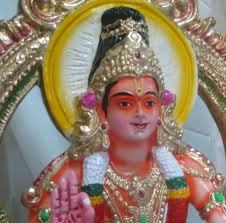 Mahishi, the asura princess, was very angry with the Devas after Devi Durga destroyed her beloved brother, Mahishasura. Hence, Mahishi began a fearful penance to appease Brahma, who granted her a boon of being invulnerable to anyone except the combined strength of Shiva and Vishnu. Drunk in this power, Mahishi began her dictatorial rule over the whole world. The gods requested Shiva and Vishnu to come up with a solution to this problem.
Mahishi, the asura princess, was very angry with the Devas after Devi Durga destroyed her beloved brother, Mahishasura. Hence, Mahishi began a fearful penance to appease Brahma, who granted her a boon of being invulnerable to anyone except the combined strength of Shiva and Vishnu. Drunk in this power, Mahishi began her dictatorial rule over the whole world. The gods requested Shiva and Vishnu to come up with a solution to this problem.
Shiva’s first son: Lord Ayyappan
 This is when Vishnu decided to assume the form of Mohini yet again, so as to procreate with Shiva. Vishnu explains the entire matter to Shiva and the latter requests to give him a glimpse of Mohini’s form. Shiva is overcome with passion on seeing “her” form and unites with her. Lord Ayyappan is born from this union of Hari and Hara. Ayyappan combines the strength of both Vishnu and Shiva and hence, is invincible.
This is when Vishnu decided to assume the form of Mohini yet again, so as to procreate with Shiva. Vishnu explains the entire matter to Shiva and the latter requests to give him a glimpse of Mohini’s form. Shiva is overcome with passion on seeing “her” form and unites with her. Lord Ayyappan is born from this union of Hari and Hara. Ayyappan combines the strength of both Vishnu and Shiva and hence, is invincible.
Shiva’s first son: Lord Ayyappan
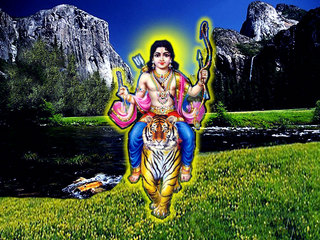 Lord Vishnu gifts the new-born infant with a small bell necklace and hence this deity is also hailed as Manikanthan Swamy. In Tamil Nadu, Shasta is also called Ayyanar or Shasthappan. While in Tamil Nadu, the legend ends with the birth of the god, the story in Kerala continues with Ayyappan’s adoption by the Pandalam Raja, and his fulfilling the mission of destroying Mahishi.
Lord Vishnu gifts the new-born infant with a small bell necklace and hence this deity is also hailed as Manikanthan Swamy. In Tamil Nadu, Shasta is also called Ayyanar or Shasthappan. While in Tamil Nadu, the legend ends with the birth of the god, the story in Kerala continues with Ayyappan’s adoption by the Pandalam Raja, and his fulfilling the mission of destroying Mahishi.
Ayyappan’s childhood
 Lord Ayyappan was adopted by the King of Pandalam, a district in Kerala. Raja Rajasekhara was the ruler Pandalam at the time. The Raja heard a child wailing on the banks of the River Pampa when he was on a hunting expedition. He was an ardent devotee of Lord Shiva and his queen was a devotee of Lord Vishnu. The King accepted the child as God’s response to their prayers for an heir to the throne. Manikantan was well versed in academics and martial arts such as Kalaripayattu, then the common tradition in Kerala.
Lord Ayyappan was adopted by the King of Pandalam, a district in Kerala. Raja Rajasekhara was the ruler Pandalam at the time. The Raja heard a child wailing on the banks of the River Pampa when he was on a hunting expedition. He was an ardent devotee of Lord Shiva and his queen was a devotee of Lord Vishnu. The King accepted the child as God’s response to their prayers for an heir to the throne. Manikantan was well versed in academics and martial arts such as Kalaripayattu, then the common tradition in Kerala.
Ayyappan’s childhood
 In the meantime, the Rani too gave birth to a son. But the king still regarded Manikantan as his elder son and hence, decided to crown him as the Yuvaraja (heir). The King’s minister was against Manikantan becoming the heir, so he, along with his cronies, manipulated the Rani and asked her to fight the king’s decision. On Manikantan’s coronation day, the queen pretended to suffer from tremendous stomach ache. A fake practitioner was called in and prescribed “the milk of a tigress” as the cure of the queen’s illness.
In the meantime, the Rani too gave birth to a son. But the king still regarded Manikantan as his elder son and hence, decided to crown him as the Yuvaraja (heir). The King’s minister was against Manikantan becoming the heir, so he, along with his cronies, manipulated the Rani and asked her to fight the king’s decision. On Manikantan’s coronation day, the queen pretended to suffer from tremendous stomach ache. A fake practitioner was called in and prescribed “the milk of a tigress” as the cure of the queen’s illness.
Manikantan kills Mahishi
 As no one else dared to come forward to complete the task, Manikantan himself volunteered and went to the forest in search of tigress milk. The king tried in vain to stop him and was constantly praying for his safety, hoping he would come back alive. Manikantan enters the forest, comes face-to-face with the terrible demoness Mahishi and slays her almost effortlessly.
As no one else dared to come forward to complete the task, Manikantan himself volunteered and went to the forest in search of tigress milk. The king tried in vain to stop him and was constantly praying for his safety, hoping he would come back alive. Manikantan enters the forest, comes face-to-face with the terrible demoness Mahishi and slays her almost effortlessly.
Lord Ayyappan disappeared
 Manikantan then enters the palace riding the very tigress, followed by her cubs. The minister, convinced of Ayyappan’s divinity, confesses to his plot and prays to him for salvation and the wellbeing of the kingdom. Manikantan disappeared forthwith, but since the king refused to eat anything if Manikantan did not come back, he gave his foster father one more Darshan before ultimately leaving. Ayyappan embraced the King, thereby granting him Moksha (salvation).
Manikantan then enters the palace riding the very tigress, followed by her cubs. The minister, convinced of Ayyappan’s divinity, confesses to his plot and prays to him for salvation and the wellbeing of the kingdom. Manikantan disappeared forthwith, but since the king refused to eat anything if Manikantan did not come back, he gave his foster father one more Darshan before ultimately leaving. Ayyappan embraced the King, thereby granting him Moksha (salvation).
Sabarimala Shrine

Annual miracle at Sabarimala
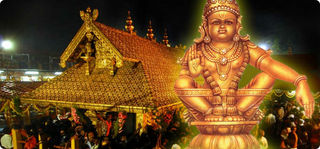 On this day, all of Ayyappan’s Tiruvaabharanam (personal jewellery) is taken from the palace and transported to the shrine. A detailed puja and aarti is performed before taking the jewels from the palace. After the aarti, the Krishnaparintha or an eagle flies overhead and circles above the devotees all the way to the shrine. Just as the Arti concludes, the Makara Jyoti appears on the east side of the Temple, up above the Hills of Kanthamalai. The light appears almost instantly after the aarti and never fails to thrill the millions of devotees.
On this day, all of Ayyappan’s Tiruvaabharanam (personal jewellery) is taken from the palace and transported to the shrine. A detailed puja and aarti is performed before taking the jewels from the palace. After the aarti, the Krishnaparintha or an eagle flies overhead and circles above the devotees all the way to the shrine. Just as the Arti concludes, the Makara Jyoti appears on the east side of the Temple, up above the Hills of Kanthamalai. The light appears almost instantly after the aarti and never fails to thrill the millions of devotees.
Shiva’s second son: Lord Ganesha
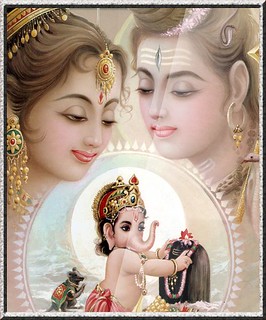 The Elephant-headed Lord, Ganesha, also known as Ganpati, Vighneshwara, Vinayaka and Pillaiyar, is one of the most popular deities in the Hindu pantheon. His image is found throughout India and Nepal and extends to Jains and Buddhists, even to other regions beyond India. Ganesha is generally regarded as the Remover of Obstacles, Lord of Beginnings and the Lord of Intellect and Wisdom. Ganesha has the head of an elephant and a big belly. He has four arms and a broken tusk.
The Elephant-headed Lord, Ganesha, also known as Ganpati, Vighneshwara, Vinayaka and Pillaiyar, is one of the most popular deities in the Hindu pantheon. His image is found throughout India and Nepal and extends to Jains and Buddhists, even to other regions beyond India. Ganesha is generally regarded as the Remover of Obstacles, Lord of Beginnings and the Lord of Intellect and Wisdom. Ganesha has the head of an elephant and a big belly. He has four arms and a broken tusk.
Birth of Ganesha
 Once, while Goddess Parvati wanted to take a bath, there were no attendants around to guard her and stop anyone from accidentally entering the house. Hence she created an image of a boy out of paste which she prepared to cleanse her body, and infused life into it, and thus Ganesha was born.
Once, while Goddess Parvati wanted to take a bath, there were no attendants around to guard her and stop anyone from accidentally entering the house. Hence she created an image of a boy out of paste which she prepared to cleanse her body, and infused life into it, and thus Ganesha was born.
Another story of the birth of Ganesha
 On the insistence of Shiva, Parvati fasted for a year to propitiate Vishnu so that he would grant her a son. Lord Vishnu, after the completion of the sacrifice, announced that he would incarnate himself as her son in every kalpa (eon). Accordingly, Krishna was born to Parvati as a charming infant. This event was celebrated with great enthusiasm and all the gods were invited to take a look at the baby. However Shani (Saturn), the son of Surya, hesitated to look at the baby since Shani was cursed with the gaze of destruction.
On the insistence of Shiva, Parvati fasted for a year to propitiate Vishnu so that he would grant her a son. Lord Vishnu, after the completion of the sacrifice, announced that he would incarnate himself as her son in every kalpa (eon). Accordingly, Krishna was born to Parvati as a charming infant. This event was celebrated with great enthusiasm and all the gods were invited to take a look at the baby. However Shani (Saturn), the son of Surya, hesitated to look at the baby since Shani was cursed with the gaze of destruction.
Another story of the birth of Ganesha
 However Parvati insisted that he look at the baby, which Shani did, and immediately the infant’s head fell off and flew to Goloka. Seeing Shiva and Parvati grief stricken, Vishnu mounted on Garuda, his divine eagle, and rushed to the banks of the Pushpa-Bhadra river, from where he brought back the head of a young elephant. The head of the elephant was joined with the headless body of Parvati’s son, thus reviving him. The infant was named Ganesha.
However Parvati insisted that he look at the baby, which Shani did, and immediately the infant’s head fell off and flew to Goloka. Seeing Shiva and Parvati grief stricken, Vishnu mounted on Garuda, his divine eagle, and rushed to the banks of the Pushpa-Bhadra river, from where he brought back the head of a young elephant. The head of the elephant was joined with the headless body of Parvati’s son, thus reviving him. The infant was named Ganesha.
Physical attributes of Ganesha
 The Ganesha Purana shows the Lord wrapping the serpent King, Vasuki, around his neck or even stomach. Other depictions include him with a yagnopavita (sacred thread), holding the Trisula (Trident) in one hand and seated on a throne. Upon Ganesha’s forehead is sometimes shown a third eye or the traditional Shaivite Tilak, which consists of three horizontal lines of Vibhuti. The Ganesha Purana also talks about Ganesha with a crescent moon on the forehead – this form is called the Balachandra.
The Ganesha Purana shows the Lord wrapping the serpent King, Vasuki, around his neck or even stomach. Other depictions include him with a yagnopavita (sacred thread), holding the Trisula (Trident) in one hand and seated on a throne. Upon Ganesha’s forehead is sometimes shown a third eye or the traditional Shaivite Tilak, which consists of three horizontal lines of Vibhuti. The Ganesha Purana also talks about Ganesha with a crescent moon on the forehead – this form is called the Balachandra.
Shiva’s third son: Lord Murugan
 Kartikeya or Murugan, also called Subramanian, is another son of Shiva and an equally popular Hindu deity, especially among Tamil Hindus. He is commonly regarded as the God of War and the protector and patron deity of Tamil Nadu. He is known by many other names, including Saravana, Senthil, Arumugam or Shanmukha (‘one with six faces’), Kumara (‘child or son’), Guhan (‘cave-dweller’), Skanda, Velan (the one with the spear) and Swaminatha.
Kartikeya or Murugan, also called Subramanian, is another son of Shiva and an equally popular Hindu deity, especially among Tamil Hindus. He is commonly regarded as the God of War and the protector and patron deity of Tamil Nadu. He is known by many other names, including Saravana, Senthil, Arumugam or Shanmukha (‘one with six faces’), Kumara (‘child or son’), Guhan (‘cave-dweller’), Skanda, Velan (the one with the spear) and Swaminatha.
The birth of Murugan
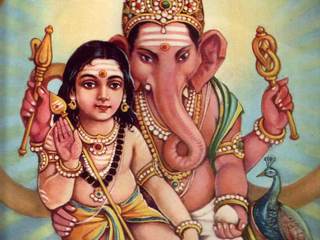 Once a cruel demon Surapadman wreaked havoc on the earth. The gods realized that only Shiva’s offspring would have the courage and valour to lead the gods to victory over Tarakasuran, Surapadman and their entire asura clan. They hatch a plan along with Kamadeva (the God of Love), to shoot flower arrows at Shiva, so as to make him fall in love with Parvati. Kamadeva aims his arrow and lets it go to Shiva, who is tremendously incensed at being disturbed during penance. He opens his third eye and instantly burns down Kamadeva to ashes. Shiva lays his eyes on Parvati and is immediately attracted towards her. Together, they leave for Kailas.
Once a cruel demon Surapadman wreaked havoc on the earth. The gods realized that only Shiva’s offspring would have the courage and valour to lead the gods to victory over Tarakasuran, Surapadman and their entire asura clan. They hatch a plan along with Kamadeva (the God of Love), to shoot flower arrows at Shiva, so as to make him fall in love with Parvati. Kamadeva aims his arrow and lets it go to Shiva, who is tremendously incensed at being disturbed during penance. He opens his third eye and instantly burns down Kamadeva to ashes. Shiva lays his eyes on Parvati and is immediately attracted towards her. Together, they leave for Kailas.
The birth of Murugan
 The sparks of this fire are so strong, that even Agni Deva (God of Fire) finds it impossible to tolerate it. The river Ganga transports the six sparks to a place located at the mouth of the Ganges, called Saravana Poigai. Here, the six sparks become six children and are raised by the six Krittika or Kartika, the stars making up the Pleiades. This is how Murugan gets his name, Kartikeya.
The sparks of this fire are so strong, that even Agni Deva (God of Fire) finds it impossible to tolerate it. The river Ganga transports the six sparks to a place located at the mouth of the Ganges, called Saravana Poigai. Here, the six sparks become six children and are raised by the six Krittika or Kartika, the stars making up the Pleiades. This is how Murugan gets his name, Kartikeya.
The birth of Murugan
 When Parvati sees the children, she is appalled, wondering how she would be able to raise six of them at the same time. The children immediately fuse into one child with six faces and twelve arms. Hence, his name also came to be Shanmukha or Aarumukha. His birth at the Saravana Poigai gave him the name Saravanabhava. Murugan then went on to become the supreme general of all the demi-gods and also successfully led armies of Devas for their fights against asuras.
When Parvati sees the children, she is appalled, wondering how she would be able to raise six of them at the same time. The children immediately fuse into one child with six faces and twelve arms. Hence, his name also came to be Shanmukha or Aarumukha. His birth at the Saravana Poigai gave him the name Saravanabhava. Murugan then went on to become the supreme general of all the demi-gods and also successfully led armies of Devas for their fights against asuras.
Legends related to Murugan
 Lord Kartikeya is portrayed as a very beautiful deity, with six heads and twelve arms. This is also one reason why he is often termed as Azhagan (the handsome one). The six heads represent the six siddhis or spiritual powers. This also corresponds to his role as the bestower of the six siddhis. Murugan is often shown riding a peacock, holding his Vel or the Divine Spear or Lance, flanked by his two wives, Valli and Devayani. He is sometimes also depicted wielding other weapons like a sword, mace, discus, javelin and bow.
Lord Kartikeya is portrayed as a very beautiful deity, with six heads and twelve arms. This is also one reason why he is often termed as Azhagan (the handsome one). The six heads represent the six siddhis or spiritual powers. This also corresponds to his role as the bestower of the six siddhis. Murugan is often shown riding a peacock, holding his Vel or the Divine Spear or Lance, flanked by his two wives, Valli and Devayani. He is sometimes also depicted wielding other weapons like a sword, mace, discus, javelin and bow.





